Making and Keeping Friends from Different Cultures: An Essay
VerifiedAdded on 2022/10/02
|8
|1816
|168
Essay
AI Summary
This essay delves into the multifaceted world of intercultural friendships, exploring the challenges and benefits of forming and maintaining relationships across different cultural backgrounds. It begins by highlighting the importance of friendships for overall well-being and then examines the cultural differences that can hinder the development of intercultural friendships, such as disparities in communication styles, values, and beliefs. The essay then discusses the benefits of intercultural friendships, including enhanced language skills, increased life satisfaction, and broader perspectives. Furthermore, it explores various strategies to improve intercultural friendships, such as fostering open communication, increasing cultural sensitivity, and promoting collaborative activities. The essay draws on research to support its claims, providing a comprehensive overview of the dynamics of intercultural friendship formation and maintenance, and offering practical recommendations for improving these relationships. This assignment is contributed by a student to Desklib, a platform providing AI-based study tools for students.
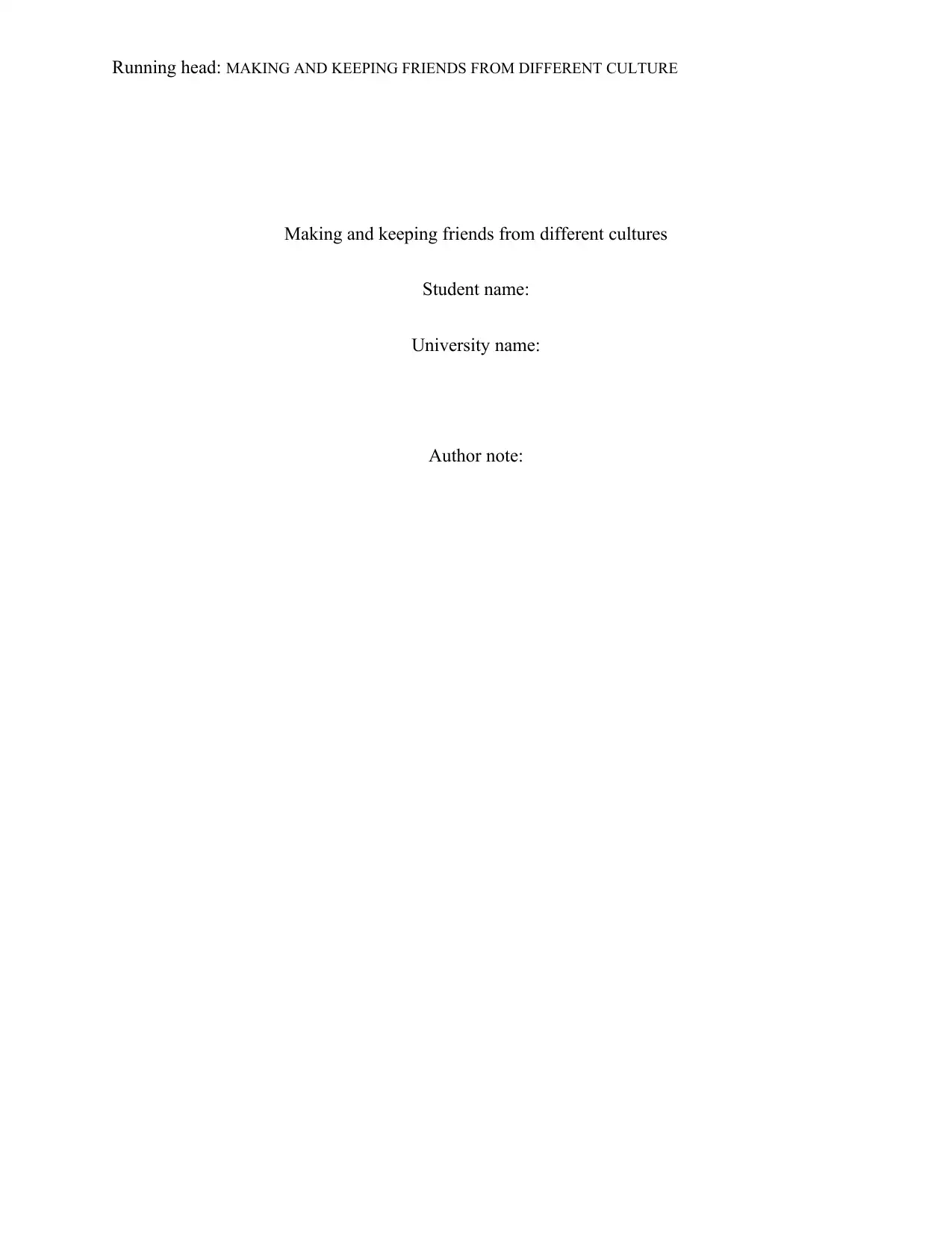
Running head: MAKING AND KEEPING FRIENDS FROM DIFFERENT CULTURE
Making and keeping friends from different cultures
Student name:
University name:
Author note:
Making and keeping friends from different cultures
Student name:
University name:
Author note:
Paraphrase This Document
Need a fresh take? Get an instant paraphrase of this document with our AI Paraphraser
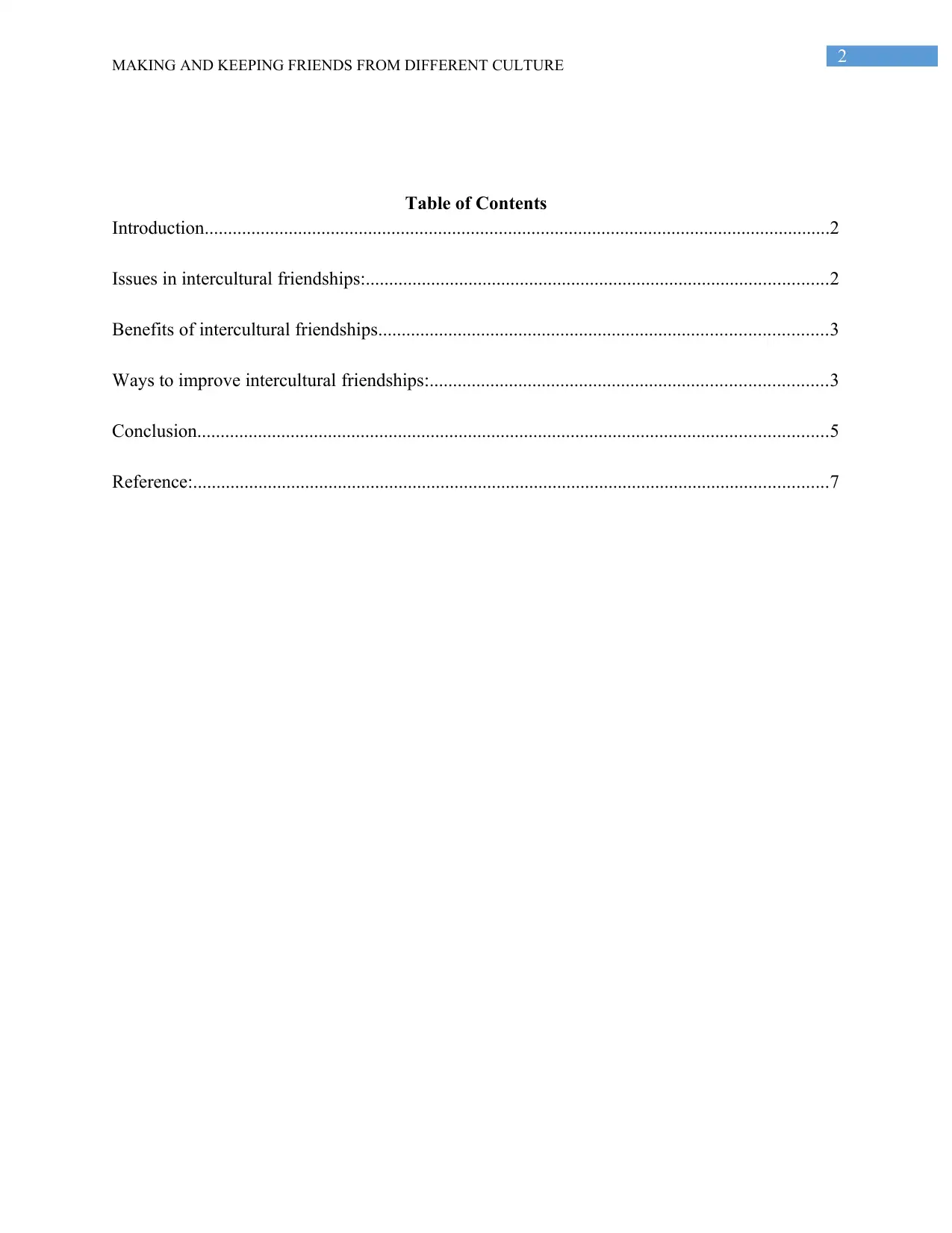
2MAKING AND KEEPING FRIENDS FROM DIFFERENT CULTURE
Table of Contents
Introduction......................................................................................................................................2
Issues in intercultural friendships:...................................................................................................2
Benefits of intercultural friendships................................................................................................3
Ways to improve intercultural friendships:.....................................................................................3
Conclusion.......................................................................................................................................5
Reference:........................................................................................................................................7
Table of Contents
Introduction......................................................................................................................................2
Issues in intercultural friendships:...................................................................................................2
Benefits of intercultural friendships................................................................................................3
Ways to improve intercultural friendships:.....................................................................................3
Conclusion.......................................................................................................................................5
Reference:........................................................................................................................................7
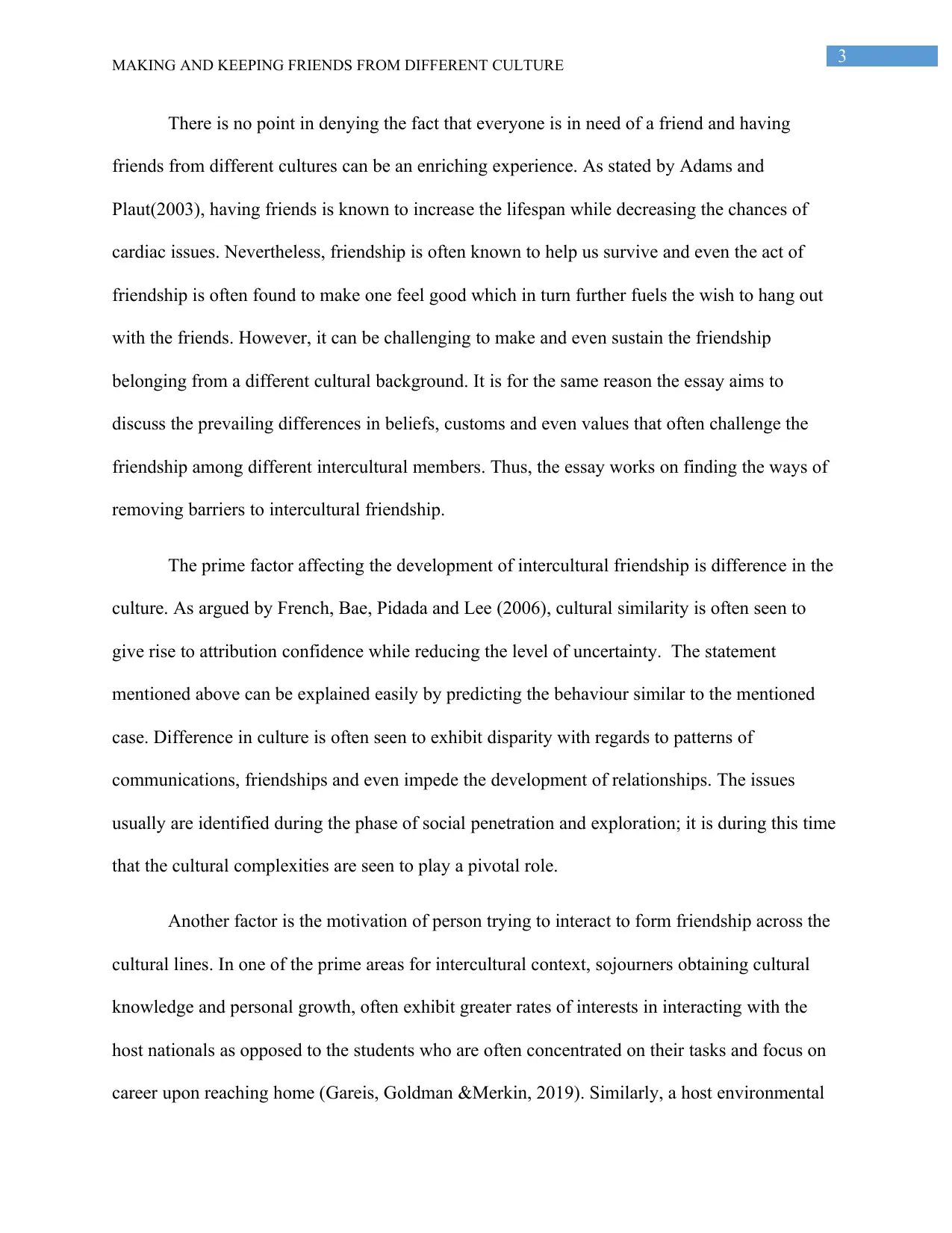
3MAKING AND KEEPING FRIENDS FROM DIFFERENT CULTURE
There is no point in denying the fact that everyone is in need of a friend and having
friends from different cultures can be an enriching experience. As stated by Adams and
Plaut(2003), having friends is known to increase the lifespan while decreasing the chances of
cardiac issues. Nevertheless, friendship is often known to help us survive and even the act of
friendship is often found to make one feel good which in turn further fuels the wish to hang out
with the friends. However, it can be challenging to make and even sustain the friendship
belonging from a different cultural background. It is for the same reason the essay aims to
discuss the prevailing differences in beliefs, customs and even values that often challenge the
friendship among different intercultural members. Thus, the essay works on finding the ways of
removing barriers to intercultural friendship.
The prime factor affecting the development of intercultural friendship is difference in the
culture. As argued by French, Bae, Pidada and Lee (2006), cultural similarity is often seen to
give rise to attribution confidence while reducing the level of uncertainty. The statement
mentioned above can be explained easily by predicting the behaviour similar to the mentioned
case. Difference in culture is often seen to exhibit disparity with regards to patterns of
communications, friendships and even impede the development of relationships. The issues
usually are identified during the phase of social penetration and exploration; it is during this time
that the cultural complexities are seen to play a pivotal role.
Another factor is the motivation of person trying to interact to form friendship across the
cultural lines. In one of the prime areas for intercultural context, sojourners obtaining cultural
knowledge and personal growth, often exhibit greater rates of interests in interacting with the
host nationals as opposed to the students who are often concentrated on their tasks and focus on
career upon reaching home (Gareis, Goldman &Merkin, 2019). Similarly, a host environmental
There is no point in denying the fact that everyone is in need of a friend and having
friends from different cultures can be an enriching experience. As stated by Adams and
Plaut(2003), having friends is known to increase the lifespan while decreasing the chances of
cardiac issues. Nevertheless, friendship is often known to help us survive and even the act of
friendship is often found to make one feel good which in turn further fuels the wish to hang out
with the friends. However, it can be challenging to make and even sustain the friendship
belonging from a different cultural background. It is for the same reason the essay aims to
discuss the prevailing differences in beliefs, customs and even values that often challenge the
friendship among different intercultural members. Thus, the essay works on finding the ways of
removing barriers to intercultural friendship.
The prime factor affecting the development of intercultural friendship is difference in the
culture. As argued by French, Bae, Pidada and Lee (2006), cultural similarity is often seen to
give rise to attribution confidence while reducing the level of uncertainty. The statement
mentioned above can be explained easily by predicting the behaviour similar to the mentioned
case. Difference in culture is often seen to exhibit disparity with regards to patterns of
communications, friendships and even impede the development of relationships. The issues
usually are identified during the phase of social penetration and exploration; it is during this time
that the cultural complexities are seen to play a pivotal role.
Another factor is the motivation of person trying to interact to form friendship across the
cultural lines. In one of the prime areas for intercultural context, sojourners obtaining cultural
knowledge and personal growth, often exhibit greater rates of interests in interacting with the
host nationals as opposed to the students who are often concentrated on their tasks and focus on
career upon reaching home (Gareis, Goldman &Merkin, 2019). Similarly, a host environmental
⊘ This is a preview!⊘
Do you want full access?
Subscribe today to unlock all pages.

Trusted by 1+ million students worldwide

4MAKING AND KEEPING FRIENDS FROM DIFFERENT CULTURE
factor such as receptivity of the host is likely to influence the intercultural friendships formed.
The other factors influencing intercultural friendships are level of communication among the
friends, and even intercultural sensitivity among the members for promoting intercultural
friendships.
Friends from different culture are important for psychological welfare as friends from
different cultural backgrounds often engage in meaningful conversations. A study conducted by
Kudo and Simkin (2003), proved the fact maintaining a rich network of friends can add
significant years to life. Unfortunately, close friendships do not happen and people are often
struggle to establish quality friendships. Irrespective of the age and even the circumstances, it is
never too late to form friendships and even reconnect with new ones. In similar ways,
intercultural friendship can seem a great way to foster friendship in between the event of
globalisation. Judging the wider range of benefits, intercultural friendship can foster better
relations between the two countries and even communities (Watson & Zhu, 2016). Benefits of
intercultural-friendship formation include stronger language skills, greater life satisfaction, lower
levels of stress, and enhanced perceptions of the host country (Belford, 2017).
Based on the research study conducted by Gareis and Jalayer (2018), semester long
ethnographic students are assigned partners that can further improve their cross cultural attitude
and knowledge; these improvements can be maintained till the end of the semester. Similarly,
evidence based study conducted by Kudo, Volet and Whitsed (2017), demonstrated that
improvement within the attitude and even knowledge is linked with keen interest in continued
contact. The pair project can help in developing intercultural friendship formation or at least
create an interested contact with their assigned partners. However, given the persistent absence
factor such as receptivity of the host is likely to influence the intercultural friendships formed.
The other factors influencing intercultural friendships are level of communication among the
friends, and even intercultural sensitivity among the members for promoting intercultural
friendships.
Friends from different culture are important for psychological welfare as friends from
different cultural backgrounds often engage in meaningful conversations. A study conducted by
Kudo and Simkin (2003), proved the fact maintaining a rich network of friends can add
significant years to life. Unfortunately, close friendships do not happen and people are often
struggle to establish quality friendships. Irrespective of the age and even the circumstances, it is
never too late to form friendships and even reconnect with new ones. In similar ways,
intercultural friendship can seem a great way to foster friendship in between the event of
globalisation. Judging the wider range of benefits, intercultural friendship can foster better
relations between the two countries and even communities (Watson & Zhu, 2016). Benefits of
intercultural-friendship formation include stronger language skills, greater life satisfaction, lower
levels of stress, and enhanced perceptions of the host country (Belford, 2017).
Based on the research study conducted by Gareis and Jalayer (2018), semester long
ethnographic students are assigned partners that can further improve their cross cultural attitude
and knowledge; these improvements can be maintained till the end of the semester. Similarly,
evidence based study conducted by Kudo, Volet and Whitsed (2017), demonstrated that
improvement within the attitude and even knowledge is linked with keen interest in continued
contact. The pair project can help in developing intercultural friendship formation or at least
create an interested contact with their assigned partners. However, given the persistent absence
Paraphrase This Document
Need a fresh take? Get an instant paraphrase of this document with our AI Paraphraser
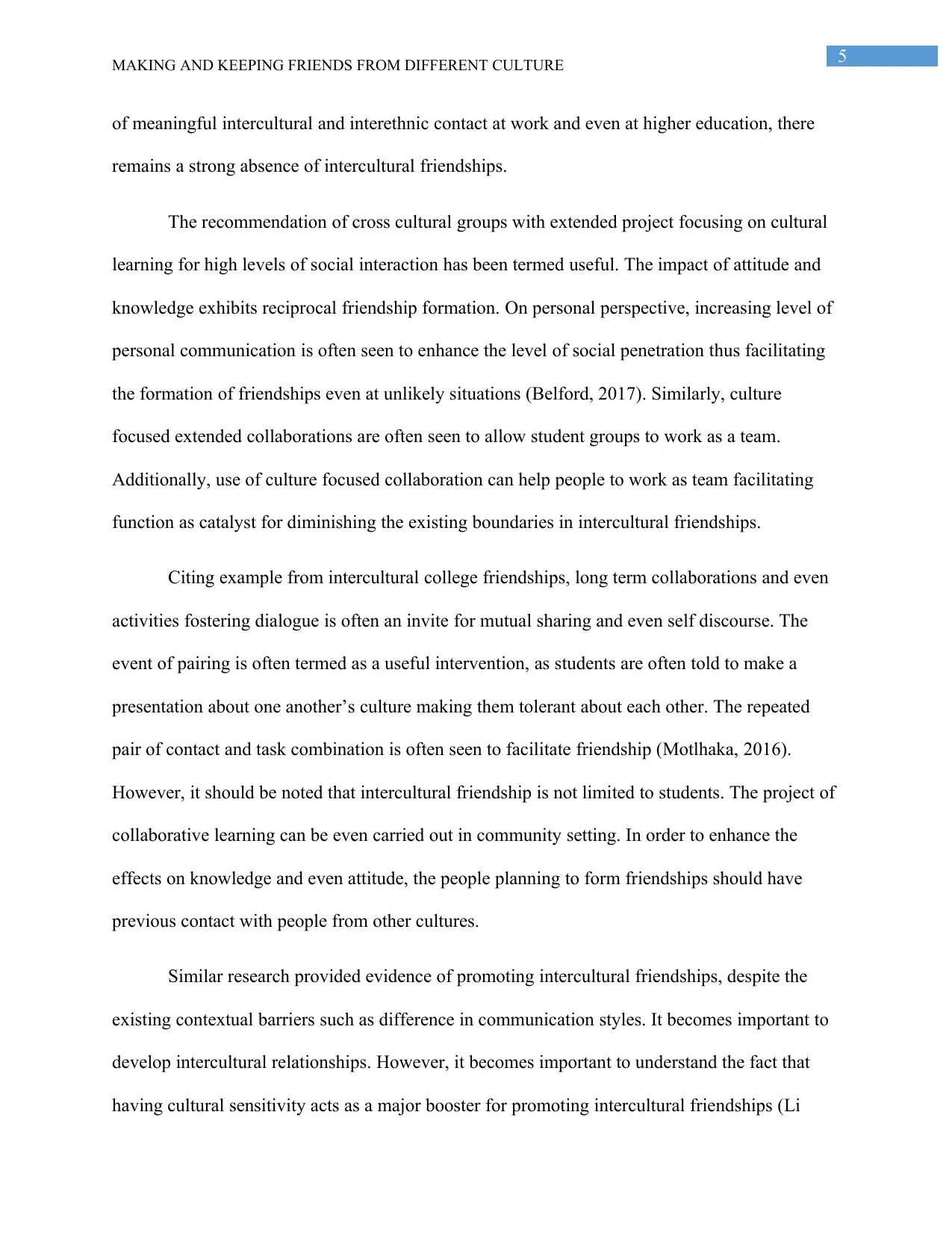
5MAKING AND KEEPING FRIENDS FROM DIFFERENT CULTURE
of meaningful intercultural and interethnic contact at work and even at higher education, there
remains a strong absence of intercultural friendships.
The recommendation of cross cultural groups with extended project focusing on cultural
learning for high levels of social interaction has been termed useful. The impact of attitude and
knowledge exhibits reciprocal friendship formation. On personal perspective, increasing level of
personal communication is often seen to enhance the level of social penetration thus facilitating
the formation of friendships even at unlikely situations (Belford, 2017). Similarly, culture
focused extended collaborations are often seen to allow student groups to work as a team.
Additionally, use of culture focused collaboration can help people to work as team facilitating
function as catalyst for diminishing the existing boundaries in intercultural friendships.
Citing example from intercultural college friendships, long term collaborations and even
activities fostering dialogue is often an invite for mutual sharing and even self discourse. The
event of pairing is often termed as a useful intervention, as students are often told to make a
presentation about one another’s culture making them tolerant about each other. The repeated
pair of contact and task combination is often seen to facilitate friendship (Motlhaka, 2016).
However, it should be noted that intercultural friendship is not limited to students. The project of
collaborative learning can be even carried out in community setting. In order to enhance the
effects on knowledge and even attitude, the people planning to form friendships should have
previous contact with people from other cultures.
Similar research provided evidence of promoting intercultural friendships, despite the
existing contextual barriers such as difference in communication styles. It becomes important to
develop intercultural relationships. However, it becomes important to understand the fact that
having cultural sensitivity acts as a major booster for promoting intercultural friendships (Li
of meaningful intercultural and interethnic contact at work and even at higher education, there
remains a strong absence of intercultural friendships.
The recommendation of cross cultural groups with extended project focusing on cultural
learning for high levels of social interaction has been termed useful. The impact of attitude and
knowledge exhibits reciprocal friendship formation. On personal perspective, increasing level of
personal communication is often seen to enhance the level of social penetration thus facilitating
the formation of friendships even at unlikely situations (Belford, 2017). Similarly, culture
focused extended collaborations are often seen to allow student groups to work as a team.
Additionally, use of culture focused collaboration can help people to work as team facilitating
function as catalyst for diminishing the existing boundaries in intercultural friendships.
Citing example from intercultural college friendships, long term collaborations and even
activities fostering dialogue is often an invite for mutual sharing and even self discourse. The
event of pairing is often termed as a useful intervention, as students are often told to make a
presentation about one another’s culture making them tolerant about each other. The repeated
pair of contact and task combination is often seen to facilitate friendship (Motlhaka, 2016).
However, it should be noted that intercultural friendship is not limited to students. The project of
collaborative learning can be even carried out in community setting. In order to enhance the
effects on knowledge and even attitude, the people planning to form friendships should have
previous contact with people from other cultures.
Similar research provided evidence of promoting intercultural friendships, despite the
existing contextual barriers such as difference in communication styles. It becomes important to
develop intercultural relationships. However, it becomes important to understand the fact that
having cultural sensitivity acts as a major booster for promoting intercultural friendships (Li
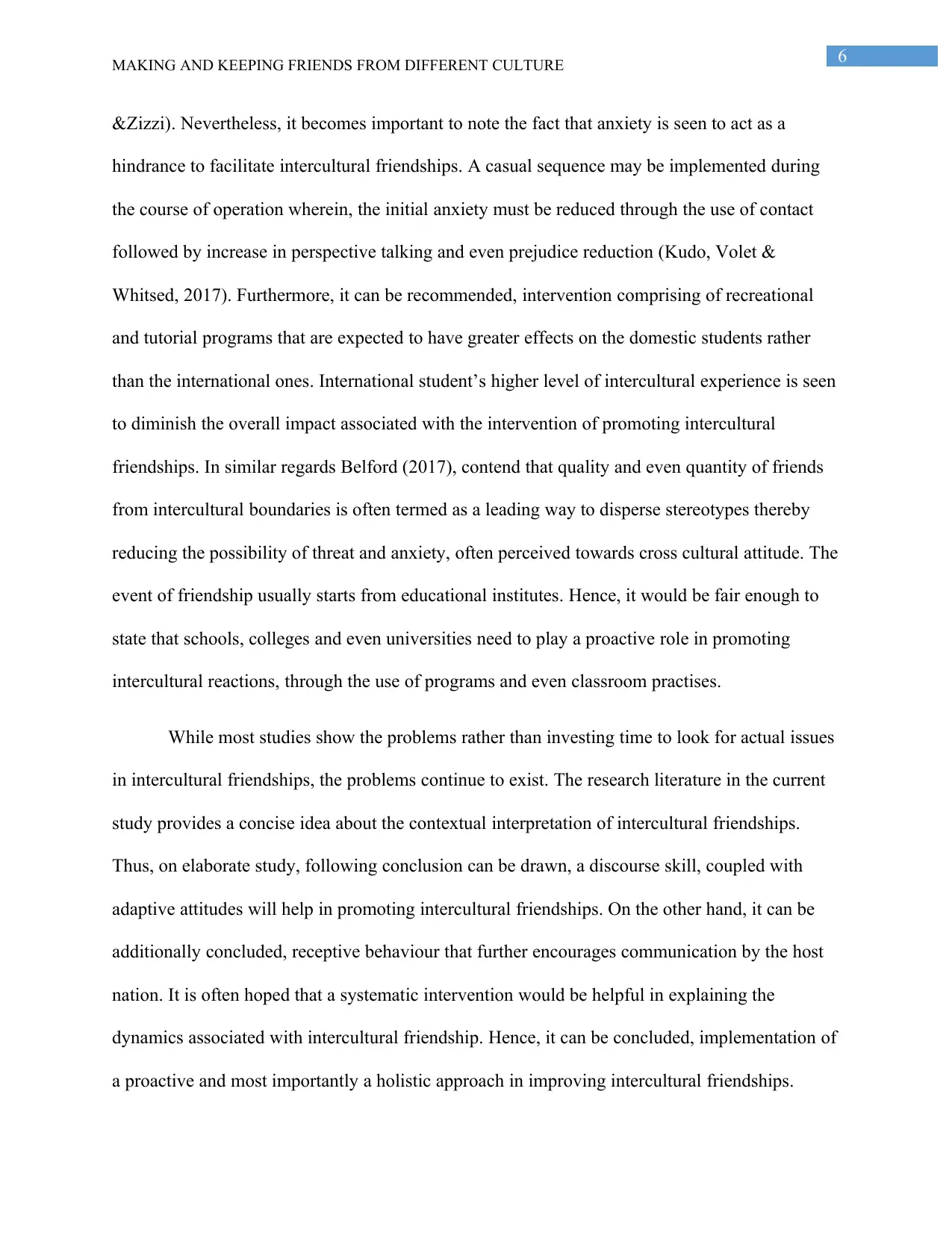
6MAKING AND KEEPING FRIENDS FROM DIFFERENT CULTURE
&Zizzi). Nevertheless, it becomes important to note the fact that anxiety is seen to act as a
hindrance to facilitate intercultural friendships. A casual sequence may be implemented during
the course of operation wherein, the initial anxiety must be reduced through the use of contact
followed by increase in perspective talking and even prejudice reduction (Kudo, Volet &
Whitsed, 2017). Furthermore, it can be recommended, intervention comprising of recreational
and tutorial programs that are expected to have greater effects on the domestic students rather
than the international ones. International student’s higher level of intercultural experience is seen
to diminish the overall impact associated with the intervention of promoting intercultural
friendships. In similar regards Belford (2017), contend that quality and even quantity of friends
from intercultural boundaries is often termed as a leading way to disperse stereotypes thereby
reducing the possibility of threat and anxiety, often perceived towards cross cultural attitude. The
event of friendship usually starts from educational institutes. Hence, it would be fair enough to
state that schools, colleges and even universities need to play a proactive role in promoting
intercultural reactions, through the use of programs and even classroom practises.
While most studies show the problems rather than investing time to look for actual issues
in intercultural friendships, the problems continue to exist. The research literature in the current
study provides a concise idea about the contextual interpretation of intercultural friendships.
Thus, on elaborate study, following conclusion can be drawn, a discourse skill, coupled with
adaptive attitudes will help in promoting intercultural friendships. On the other hand, it can be
additionally concluded, receptive behaviour that further encourages communication by the host
nation. It is often hoped that a systematic intervention would be helpful in explaining the
dynamics associated with intercultural friendship. Hence, it can be concluded, implementation of
a proactive and most importantly a holistic approach in improving intercultural friendships.
&Zizzi). Nevertheless, it becomes important to note the fact that anxiety is seen to act as a
hindrance to facilitate intercultural friendships. A casual sequence may be implemented during
the course of operation wherein, the initial anxiety must be reduced through the use of contact
followed by increase in perspective talking and even prejudice reduction (Kudo, Volet &
Whitsed, 2017). Furthermore, it can be recommended, intervention comprising of recreational
and tutorial programs that are expected to have greater effects on the domestic students rather
than the international ones. International student’s higher level of intercultural experience is seen
to diminish the overall impact associated with the intervention of promoting intercultural
friendships. In similar regards Belford (2017), contend that quality and even quantity of friends
from intercultural boundaries is often termed as a leading way to disperse stereotypes thereby
reducing the possibility of threat and anxiety, often perceived towards cross cultural attitude. The
event of friendship usually starts from educational institutes. Hence, it would be fair enough to
state that schools, colleges and even universities need to play a proactive role in promoting
intercultural reactions, through the use of programs and even classroom practises.
While most studies show the problems rather than investing time to look for actual issues
in intercultural friendships, the problems continue to exist. The research literature in the current
study provides a concise idea about the contextual interpretation of intercultural friendships.
Thus, on elaborate study, following conclusion can be drawn, a discourse skill, coupled with
adaptive attitudes will help in promoting intercultural friendships. On the other hand, it can be
additionally concluded, receptive behaviour that further encourages communication by the host
nation. It is often hoped that a systematic intervention would be helpful in explaining the
dynamics associated with intercultural friendship. Hence, it can be concluded, implementation of
a proactive and most importantly a holistic approach in improving intercultural friendships.
⊘ This is a preview!⊘
Do you want full access?
Subscribe today to unlock all pages.

Trusted by 1+ million students worldwide
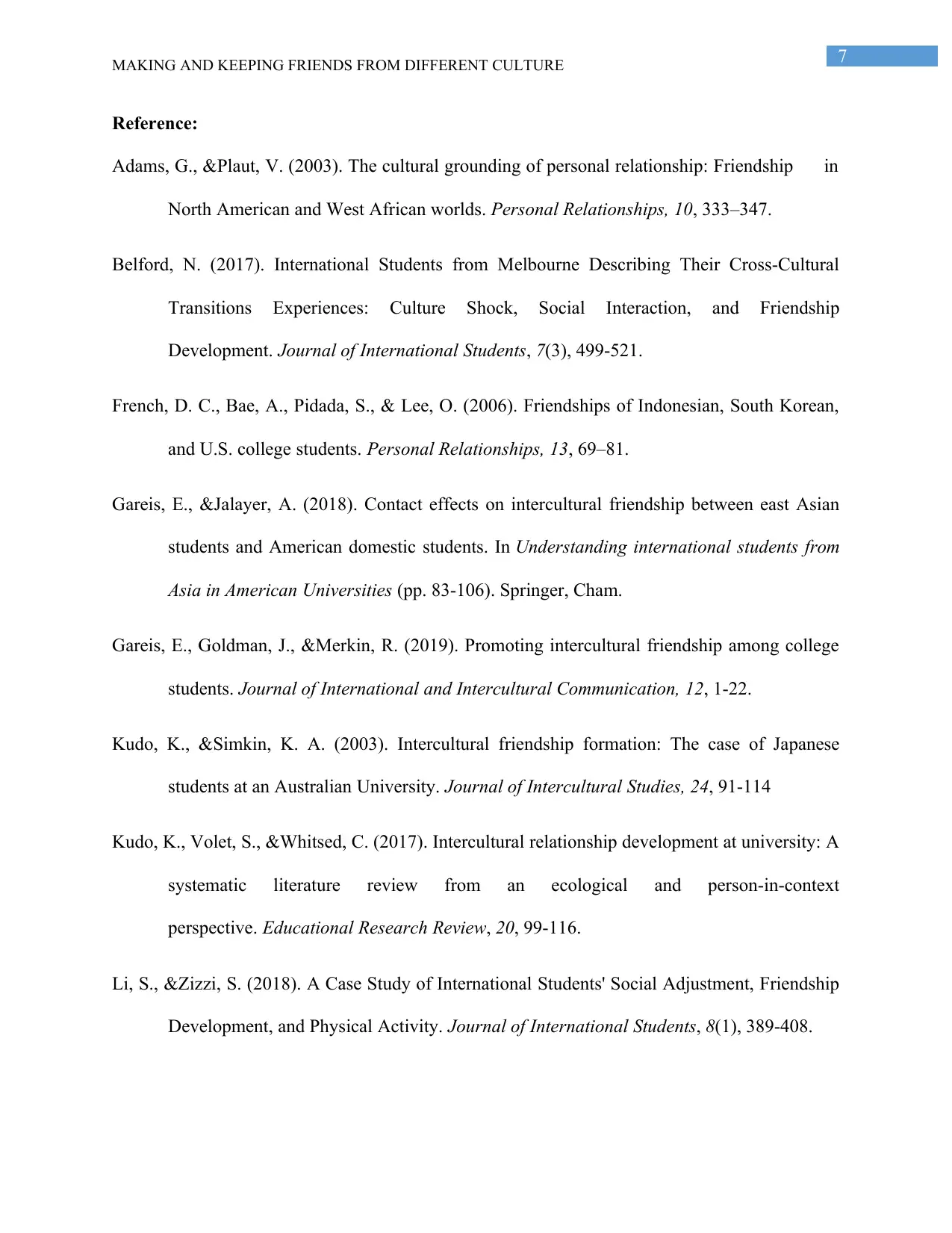
7MAKING AND KEEPING FRIENDS FROM DIFFERENT CULTURE
Reference:
Adams, G., &Plaut, V. (2003). The cultural grounding of personal relationship: Friendship in
North American and West African worlds. Personal Relationships, 10, 333–347.
Belford, N. (2017). International Students from Melbourne Describing Their Cross-Cultural
Transitions Experiences: Culture Shock, Social Interaction, and Friendship
Development. Journal of International Students, 7(3), 499-521.
French, D. C., Bae, A., Pidada, S., & Lee, O. (2006). Friendships of Indonesian, South Korean,
and U.S. college students. Personal Relationships, 13, 69–81.
Gareis, E., &Jalayer, A. (2018). Contact effects on intercultural friendship between east Asian
students and American domestic students. In Understanding international students from
Asia in American Universities (pp. 83-106). Springer, Cham.
Gareis, E., Goldman, J., &Merkin, R. (2019). Promoting intercultural friendship among college
students. Journal of International and Intercultural Communication, 12, 1-22.
Kudo, K., &Simkin, K. A. (2003). Intercultural friendship formation: The case of Japanese
students at an Australian University. Journal of Intercultural Studies, 24, 91-114
Kudo, K., Volet, S., &Whitsed, C. (2017). Intercultural relationship development at university: A
systematic literature review from an ecological and person-in-context
perspective. Educational Research Review, 20, 99-116.
Li, S., &Zizzi, S. (2018). A Case Study of International Students' Social Adjustment, Friendship
Development, and Physical Activity. Journal of International Students, 8(1), 389-408.
Reference:
Adams, G., &Plaut, V. (2003). The cultural grounding of personal relationship: Friendship in
North American and West African worlds. Personal Relationships, 10, 333–347.
Belford, N. (2017). International Students from Melbourne Describing Their Cross-Cultural
Transitions Experiences: Culture Shock, Social Interaction, and Friendship
Development. Journal of International Students, 7(3), 499-521.
French, D. C., Bae, A., Pidada, S., & Lee, O. (2006). Friendships of Indonesian, South Korean,
and U.S. college students. Personal Relationships, 13, 69–81.
Gareis, E., &Jalayer, A. (2018). Contact effects on intercultural friendship between east Asian
students and American domestic students. In Understanding international students from
Asia in American Universities (pp. 83-106). Springer, Cham.
Gareis, E., Goldman, J., &Merkin, R. (2019). Promoting intercultural friendship among college
students. Journal of International and Intercultural Communication, 12, 1-22.
Kudo, K., &Simkin, K. A. (2003). Intercultural friendship formation: The case of Japanese
students at an Australian University. Journal of Intercultural Studies, 24, 91-114
Kudo, K., Volet, S., &Whitsed, C. (2017). Intercultural relationship development at university: A
systematic literature review from an ecological and person-in-context
perspective. Educational Research Review, 20, 99-116.
Li, S., &Zizzi, S. (2018). A Case Study of International Students' Social Adjustment, Friendship
Development, and Physical Activity. Journal of International Students, 8(1), 389-408.
Paraphrase This Document
Need a fresh take? Get an instant paraphrase of this document with our AI Paraphraser

8MAKING AND KEEPING FRIENDS FROM DIFFERENT CULTURE
Motlhaka, H. A. (2016). Motives for Intercultural Friendships in Higher Education: A Case
Study of First-year ESL Students and Native Speakers of English. Journal of Social
Sciences, 47(1), 33-40.
Watson, J., & Zhu, H. (2016). Intercultural learning and friendship development in short-term
intercultural education programmes. Sociological Studies of Children and Youth, 21, 231-
251.
Motlhaka, H. A. (2016). Motives for Intercultural Friendships in Higher Education: A Case
Study of First-year ESL Students and Native Speakers of English. Journal of Social
Sciences, 47(1), 33-40.
Watson, J., & Zhu, H. (2016). Intercultural learning and friendship development in short-term
intercultural education programmes. Sociological Studies of Children and Youth, 21, 231-
251.
1 out of 8
Related Documents
Your All-in-One AI-Powered Toolkit for Academic Success.
+13062052269
info@desklib.com
Available 24*7 on WhatsApp / Email
![[object Object]](/_next/static/media/star-bottom.7253800d.svg)
Unlock your academic potential
Copyright © 2020–2025 A2Z Services. All Rights Reserved. Developed and managed by ZUCOL.





